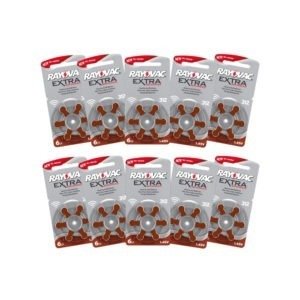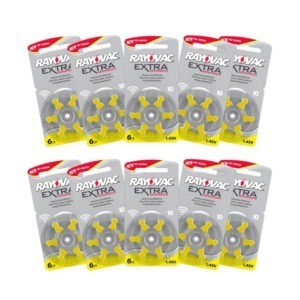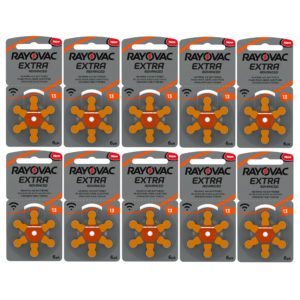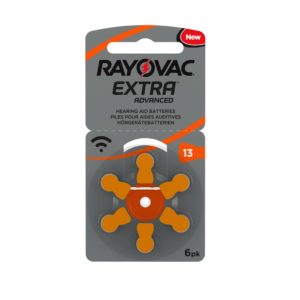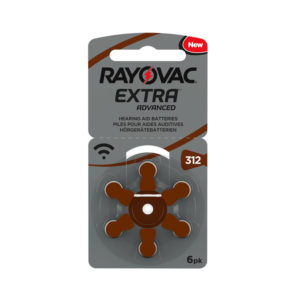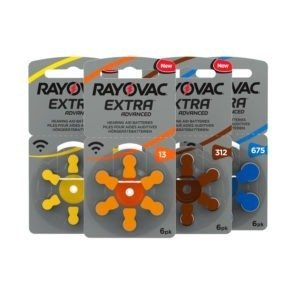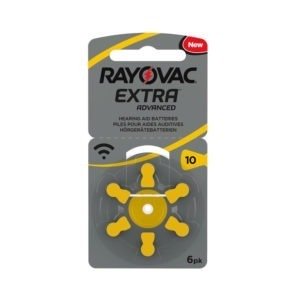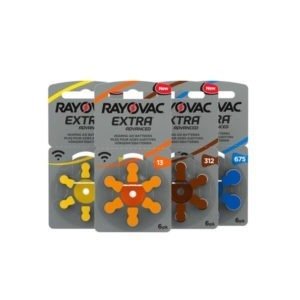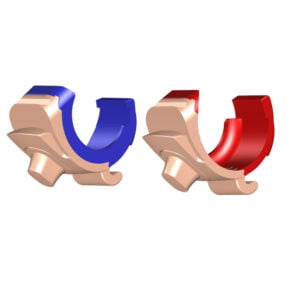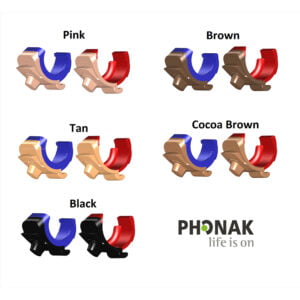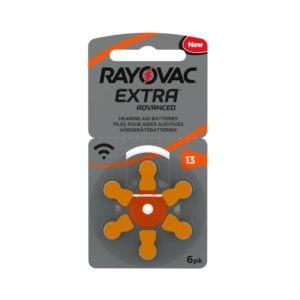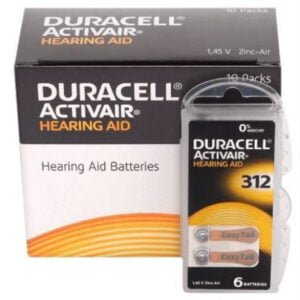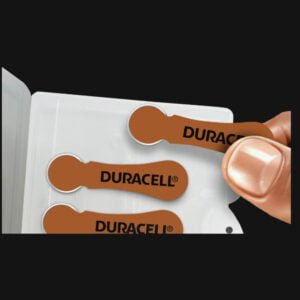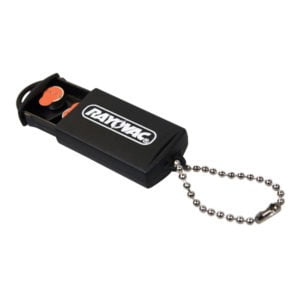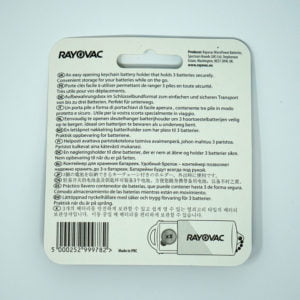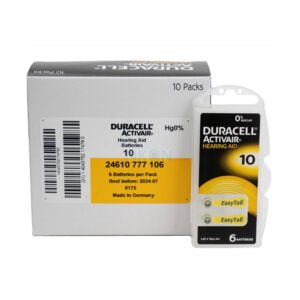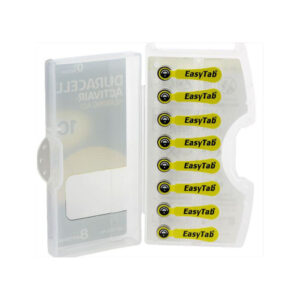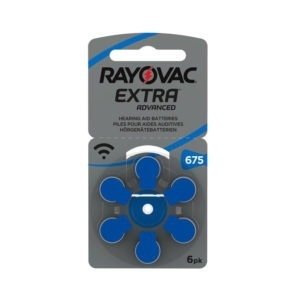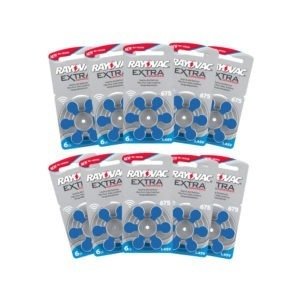Hearing Aid Batteries
Reliable hearing aid batteries can make the difference between crystal-clear hearing and an unreliable earpiece. We pride ourselves on offering a wide selection of batteries in various sizes, including 10, 13, 312, and 675. We only stock trusted brands such as Phonak and Rayovac, ensuring you receive the highest quality products.
-
RAYOVAC Extra Hearing Aid Batteries Size 312 …
- £16.99 Inc. VAT
- A replacement pack of 60 size 312 Rayovac Zinc Air Extra hearing aid batteries. Ideal for selected Phonak, GN ReSound, WIDEX, Oticon and Starkey battery-powered hearing aids. Brand: Rayovac This product includes: 60 x Rayovac Hearing Aid Batteries Size 312
- Add to basket
-
RAYOVAC Extra Hearing Aid Batteries Size 10 &…
- £16.99 Inc. VAT
- A replacement pack of 60 size 10 Rayovac Zinc Air Extra hearing aid batteries. Ideal for selected Phonak, GN ReSound, WIDEX, Oticon and Starkey battery-powered hearing aids. Brand: Rayovac This product includes: 60x Rayovac Hearing Aid Batteries Size 10
- Add to basket
-
RAYOVAC Extra Hearing Aid Batteries Size 13 &…
- £16.99 Inc. VAT
- A replacement pack of 60 size 13 Rayovac Zinc Air Extra hearing aid batteries. Ideal for selected Phonak, GN ReSound, WIDEX, Oticon and Starkey battery-powered hearing aids. Brand: Rayovac This product includes: 60x Rayovac Hearing Aid Batteries Size 13
- Add to basket
-
Rayovac Size 312 Hearing Aid Batteries Zinc A…
- £3.99 Inc. VAT
- Single packet of 6 batteries, handy to keep with you on the go or if you’re going away. Ideal for Phonak, Resound, idex, Oticon and Starkey hearing aids. Brand : Rayovac
- Add to basket
-
Rayovac Size 10 Hearing Aid Batteries Zinc Ai…
- £3.99 Inc. VAT
- This replacement pack of 6, Size 10 Rayovac Zinc Air Extra hearing aid batteries (card of 6 cells) is ideal for Phonak, Resound, Widex, Oticon and Starkey hearing aids. Brand: Rayovac Includes: 1x card of 6x battery cells
- Add to basket
-
Phonak ITE Size 10 Battery Door – Repla…
- £9.99 Inc. VAT
- This replacement battery door for selected Phonak ITE (In The Ear) hearing aids. These battery doors are suitable for most ITE Marvel, Belong & Venture hearing aids with a size 10 battery. If you are unsure about your device's compatibility, then it is recommended to check with your audiologist or our dedicated support staff. Brand: Phonak Includes: x1 Replacement Battery…
- Select options This product has multiple variants. The options may be chosen on the product page
-
Rayovac Size 13 Hearing Aid Batteries Zinc Ai…
- £3.99 Inc. VAT
- Single packet of 6 batteries, handy to keep with you on the go or if you’re going away. Ideal for Phonak, Resound, idex, Oticon and Starkey hearing aids. Brand : Rayovac
- Add to basket
-
Duracell EasyTab/Activair Type 312 Hearing Ai…
- £16.99 Inc. VAT
- A Replacement box of 60 size 312 Duracell Activair Hearing Aid Batteries. Ideal for Phonak, Resound, Widex, Oticon, Signia & Starkey hearing aids. Brand: Duracell Includes: 60x Duracell Activair size 312 Hearing Aid Batteries.
- Add to basket
-
- Out of Stock
Rayovac Hearing Aid Battery Holder Case…
- £1.99 Inc. VAT
- A handy and convenient battery holder, perfect for carrying your spare hearing aid batteries discreetly. Brand: Rayovac Included: 1 x Rayovac Hearing Aid Battery Holder
- Read more
-
-
Duracell EasyTab/Activair Type 10 Hearing Aid…
- £16.99 Inc. VAT
- A replacement box of 60 size 10 Duracell Activair Hearing Aid Batteries. Ideal for Phonak, Resound, Widex, Oticon, Signia & Starkey hearing aids. Brand: Duracell Includes: 60x Duracell Activair size 10 Hearing Aid Batteries.
- Add to basket
-
Rayovac Size 675 Hearing Aid Batteries Zinc A…
- £3.99 Inc. VAT
- A single packet of 6 batteries, handy to keep with you while you're on-the-go or on your travels. Ideal for Phonak, Resound, idex, Oticon and Starkey hearing aids. Brand: Rayovac Includes: 1x pack of 6 batteries.
- Add to basket
-
RAYOVAC Extra Hearing Aid Batteries Size 675 …
- £16.99 Inc. VAT
- A replacement pack of 60 size 675 Rayovac Zinc Air Extra hearing aid batteries. Ideal for selected Phonak, GN ReSound, WIDEX, Oticon and Starkey battery-powered hearing aids. Brand: Rayovac This product includes: 60x Rayovac Extra Hearing Aid Batteries Size 675
- Add to basket
FAQ
What sizes of hearing aid batteries are available?
There are four main sizes of hearing aid batteries, colour-coded and numbered for easy identification. Manufacturers are also developing even smaller batteries that retain the same power.
- Blue 675: The largest hearing aid battery, providing the greatest amount of power.
- Orange 13: Commonly used in smaller behind-the-ear hearing aids and larger in-the-ear models.
- Brown 312: Similar circumference as the 13 but half the depth, making it slightly fiddlier. Suitable for smaller behind-the-ear aids.
- Yellow 10: The smallest battery, designed for in-the-canal hearing aids.
How long do hearing aid batteries last?
Hearing aid batteries usually last between 5 to 10 days, depending on the size:
- Blue Size 675: 7-10 days
- Orange Size 13: 7-10 days
- Brown Size 312: 5-7 days
- Yellow Size 10: 7-10 days
What are hearing aid batteries made of?
Hearing aid batteries typically use zinc air technology, which oxidises zinc with oxygen from the air. This ensures they are safe and efficient to use.
How do I place the battery in my hearing aid?
Most batteries have a peel-off back. Once removed, place the battery carefully inside the hearing aid. Allow the battery to sit for a minute after removing the peel to maximise its oxygen reserve, which can extend battery life.
What happens when I put a battery in my hearing aid?
After you’ve placed the battery in your hearing aid, it begins to work immediately, powering your device. Letting the battery sit for a minute after peeling off the back ensures optimal performance.
How should I store hearing aid batteries?
Store hearing aid batteries at room temperature, avoiding damp areas and extreme temperatures. Proper storage maximises their lifespan and maintains their quality.
How do rechargeable hearing aid batteries work?
Most rechargeable batteries use Li-ion (Lithium Ion) technology, known for its efficiency and long-term power storage. These batteries are increasingly being integrated directly into hearing aids, providing protection against water damage and eliminating the need for manual battery changes.
What is the advantage of built-in batteries?
Having the battery built into the hearing aid prevents water damage and simplifies usage, as there’s no need to remove or insert batteries manually.
Do I need a hearing aid dryer?
Hearing aid dryers, such as drying boxes, help extend the lifespan of both your hearing aids and their batteries by removing moisture. This is particularly important if you live in a humid environment or are prone to perspiration.

